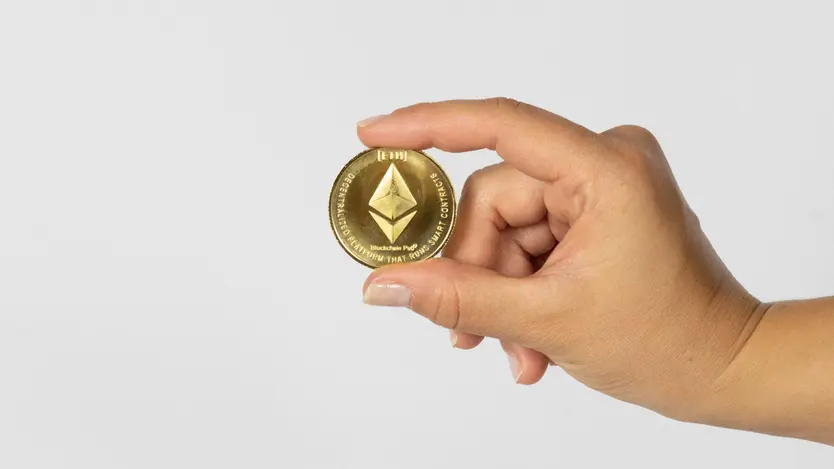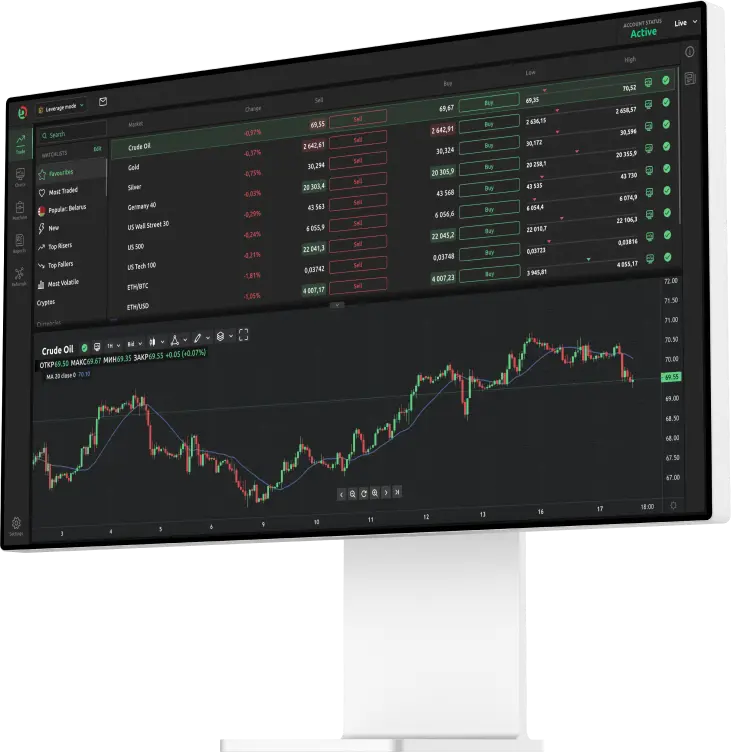Read our simple guide to the world’s second-biggest cryptocurrency

In this guide
- Ether definition
- Who created Ethereum?
- EIP-1559
- ETH price history
- Who accepts Ethereum coin?
- Trade Ethereum to US Dollar – ETH/USD chart
Every main character needs a rival. In Bitcoin’s case, it’s Ethereum. Both are the blockchains on which the two rival cryptocurrencies – ether (ETH) and bitcoin (BTC) – run.
The ETH cryptocurrency may be a distant second to BTC in terms of market capitalisation, but there are many people who believe it is more flexible and has far more uses. But what is ether – or ETH – exactly?
Let’s cut through the noise with a straightforward guide.
Ether definition
Any guide worth its salt starts with a definition. When it comes to ether as in the currency, the dictionary describes it as being about either clear skies (as in “aether”, the literary spelling, from which we also get the word “ethereal”) or anaesthesia – neither of which has anything to do with this coin.
So what is ETH in the crypto world? Well, it’s a form of digital money that is used primarily on the Ethereum platform. The Ethereum coin, as it is sometimes referred to, can be transferred immediately to people you know over the internet – usually, for a far lower fee than that for any more-established, mainstream rivals.
You could compare ether to cash. When Emma gives Jack a $5 note, no third party needs to verify that the transaction has taken place. The same would happen if she sent him 1ETH (except for the fact that Jack would be much happier, as 1ETH is worth more than $2,000).
Ether’s main purpose arguably extends beyond offering a form of digital money. It helps to keep the Ethereum blockchain running. This is because the Ethereum network is actually home to an array of decentralised apps. Known as DApps for short, these open-source applications are beginning to deliver more-efficient, blockchain-based alternatives to tools we use every day, such as bank transactions.
Whenever transactions are made and operations are completed on the network, it costs a tiny fraction of ether (ETH) – also known as a gas fee. Gas fees measure exactly how much computational power any given transaction requires before it can be recorded on a blockchain network. ETH is used to pay for the gas fees when transacting on the Ethereum blockchain.
Who created Ethereum?
The Ethereum blockchain was the brainchild of a teenage Canadian-Russian programmer named Vitalik Buterin.
Buterin had become involved in cryptocurrencies and blockchains when he became interested in Bitcoin in 2011 as a 17-year-old programmer about two years after Bitcoin was launched. He later co-founded Bitcoin Magazine.
However, Buterin soon became convinced that Bitcoin was simply too limited in scope. As reported in Forbes, he said: “I thought [those in the Bitcoin community] weren’t approaching the problem in the right way. I thought they were going after individual applications; they were trying to kind of explicitly support each [use case] in a sort of Swiss Army knife protocol.”
Buterin then enlisted seven others as co-founders. A crowdsourcing campaign for ETH tokens was held in the summer of 2014, which succeeded in raising about $18m.
EIP-1559
On 5 August 2021, Ethereum received its much-anticipated update at the London Hard Fork, which consists of five Ethereum Improvement Proposals (EIPs).
The EIP that had the most attention was EIP-1559. One of the changes EIP-1559 will bring about is that it means the crypto will shift from proof-of-work (PoW) to proof-of-stake (PoS). PoS allows crypto miners to mine or validate block transactions based on the number of coins a miner holds.
PoW is the original consensus algorithm in blockchain technology, which is used to confirm transactions and add new blocks to the chain. PoW does require huge amounts of energy, whereas PoS gives miners power based on the percentage of coin held by the miner. Bitcoin (BTC) runs on a PoW system.
The new upgrade also means some of the ETH paid to miners will now be “burned”, and thus miners will receive a loss of revenue. Before the EIP-1559 update, those who created transfers or transactions on the ETH blockchain would pay a “gas fee” in ETH for miners to process their transactions, yet without knowing the exact price to pay beforehand. To assist with the transaction getting processed, users may overpay to ensure the transfer goes through.
Other users encounter uncertainty as to whether the transaction will go ahead smoothly and in a timely fashion.
The idea is that this will enable clear pricing on a base-transaction fee paid to miners in ETH. Still, an amount of the ETH tokens will be burnt and taken out of the system permanently. EIP-1559 will reduce the supply of ETH and the income of miners.
Aleksandr Smirnin, chief operating officer (COO) at CryptoWallet, told Dzengi.com this makes ETH “scarcer, increasing its buying power and reducing network transaction fees”.
The COO also draws the comparison between EIP-1559 and the halving of BTC. The last BTC halving took place in May 2020, when the number of BTCs entering circulation every 10 minutes dropped by half to 6.25 from 12.5. The idea behind this move was to drive up the price of BTC.
ETH price history
Let’s take a look now at how the value of the Ethereum coin has appreciated since its network went live in July 2015, about a year after the crowdsourcing campaign.
After the excitement surrounding ETH began to cool slightly, the coin mostly traded under a dollar for the rest of the year. Things started to get interesting for early ETH adopters in 2016. Prices ballooned from about $0.95 on 1 January to $20.59 on 16 June, before trading at about $7 or $8 until the year’s end. Little did investors know, a crypto boom was just around the corner.
ETH grew over the next year or so, reaching $1,432.88 on 13 January 2018 before dropping back to below $100 at the end of the year. In 2019, it repeatedly broke $200, largely fuelled by excitement that some major companies had chosen to build their projects on Ethereum’s network – Microsoft, Amazon and JPMorgan among them.
In 2020, the value of ETH took a hit as the Covid-19 pandemic started, dropping to $113 on 17 March, but it recovered and ended the year at $737.80.
The start of 2021 was a boom time for crypto, and ETH broke its January 2018 record when it hit $1,443.89 on 2 February. Remarkably, the price kept going up, and it briefly broke through $2,000 on 20 February before dipping to $1,415 as the month ended. It then grew steadily, and on 12 May reached an all-time high of $4,306.26.
It was after that when things started to go downhill. The crypto crashes of late May, sparked by Chinese rulings against crypto, hit Ethereum. As of 23 May 2021, the crypto stood at $1,905.57 – less than half of what it had been just 11 days earlier. However, it managed to rally a little, recovering to just over $2,100 on 29 June.
ETH/USD price history
| Date | Close | Change | Chg% | Open | Min. | Max. |
|---|---|---|---|---|---|---|
| 2022-09-30 | 2940.66 | -6.07 | -0.21 | 2946.73 | 2938.96 | 2949.38 |
| 2022-09-30 | 2946.66 | 20.96 | 0.72 | 2925.7 | 2915.57 | 2959.32 |
| 2022-09-30 | 2925.48 | 23.32 | 0.80 | 2902.16 | 2892.71 | 2992.07 |
| 2022-09-30 | 2902.19 | -43.86 | -1.49 | 2946.05 | 2889.66 | 2971.06 |
| 2022-09-30 | 2945.95 | -18.62 | -0.63 | 2964.57 | 2888.02 | 2977.42 |
| 2022-09-30 | 2964.42 | -44.84 | -1.49 | 3009.26 | 2900.51 | 3035.02 |
| 2022-09-30 | 3009.27 | 7.16 | 0.24 | 3002.11 | 2962.33 | 3076.84 |
| 2022-09-30 | 3002.1 | 25.81 | 0.87 | 2976.29 | 2942.71 | 3011.88 |
| 2022-09-30 | 2976.81 | -1.55 | -0.05 | 2978.36 | 2965.42 | 2993.46 |
| 2022-09-30 | 2978.11 | 152.03 | 5.38 | 2826.08 | 2806.56 | 3017.37 |
| 2022-09-30 | 2825.99 | -6.24 | -0.22 | 2832.23 | 2774.53 | 2996.1 |
| 2022-09-30 | 2832.09 | -129.80 | -4.38 | 2961.89 | 2789.25 | 3029.58 |
| 2022-09-30 | 2962.06 | -1.78 | -0.06 | 2963.84 | 2876.88 | 2981.66 |
| 2022-09-30 | 2963.88 | -99.44 | -3.25 | 3063.32 | 2893.85 | 3177.34 |
| 2022-09-30 | 3063.39 | -52.37 | -1.68 | 3115.76 | 3026.83 | 3130.77 |
| 2022-09-30 | 3115.59 | 30.57 | 0.99 | 3085.02 | 3078.54 | 3136.4 |
| 2022-09-30 | 3084.4 | -152.92 | -4.72 | 3237.32 | 3045.24 | 3266.49 |
| 2022-09-30 | 3237.51 | -87.73 | -2.64 | 3325.24 | 3146.09 | 3328.95 |
| 2022-09-30 | 3325.26 | 7.44 | 0.22 | 3317.82 | 3289.34 | 3448.48 |
| 2022-09-30 | 3318.06 | 192.92 | 6.17 | 3125.14 | 3091.54 | 3398.67 |
Who accepts Ethereum coin?
You will find ETH currency on all major exchanges, given its established reputation as the world’s second-largest cryptocurrency. Like BTC, ETH has somewhat struggled to gain widespread acceptance across mainstream retailers – however, if you’re determined, it is possible to find electronics stores, pet shops and travel companies that embrace using ETH as a form of payment.
One particular boost for the Ethereum coin lies in how fintech companies are beginning to release cards that can be topped up with crypto and used as normal in brick-and-mortar businesses. Here’s how it works: Polly loads 10ETH onto her card, and whenever she makes a purchase – perhaps a snazzy new laptop – 2ETH is instantly converted into dollars.
In the coming months, keep a watchful eye on decentralised finance, as Ethereum is an established player in this industry. We are increasingly seeing platforms pop up where users may be able to earn interest on the ETH they save, lend it to others and even get a loan on the basis of their holding.
What is ETH going to be worth by the end of this year? Will it be able to snatch market share away from BTC? Are new uses going to continue popping up? We may have to wait for answers to these burning questions, but given how actively development is continuing on the network, with a system-wide upgrade called Ethereum 2.0 set to be completed by 2022, some analysts are optimistic.
Enhanced infrastructure could pave the way for more imaginative projects that break into the mainstream. It is also hoped that Ethereum 2.0 will solve long-standing capacity issues, as the blockchain can only handle 15 transactions a second at present.
The entire cryptocurrency market has taken a hit in recent weeks. We will have to see how well ETH, with its market cap of nearly $250bn, can respond.
Trade Ethereum to US Dollar – ETH/USD chart
Teenage programmer Vitalik Buterin, who had been inspired by Bitcoin. After a crowd sale of tokens in summer 2014, $18m was raised.
ETH is a form of digital money that can be transferred immediately over the internet, for a lower fee than more-established rivals.
ETH is the abbreviation for the cryptocurrency, primarily used on the Ethereum platform. The blockchain can handle 15 ETH transactions a second at present.



